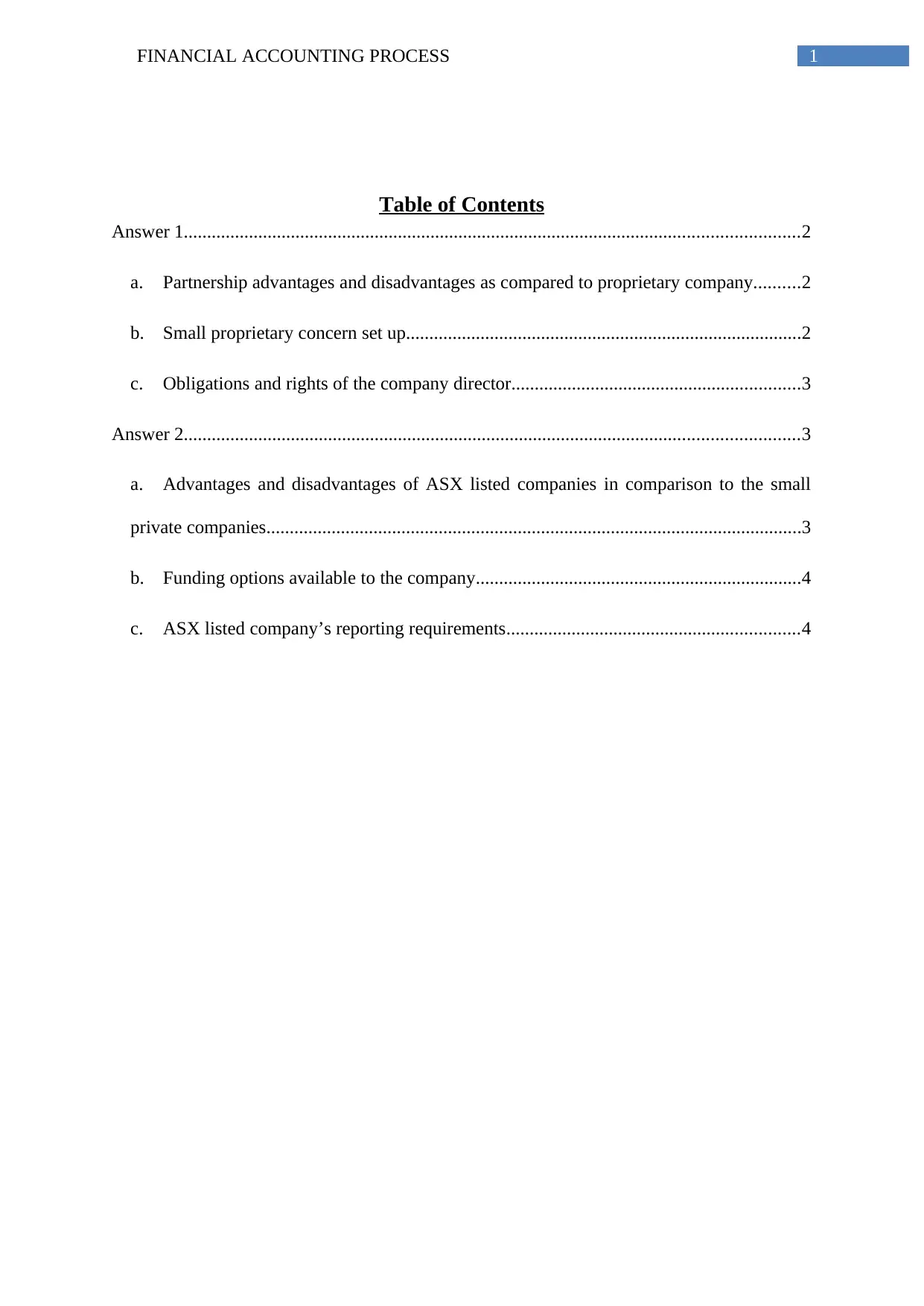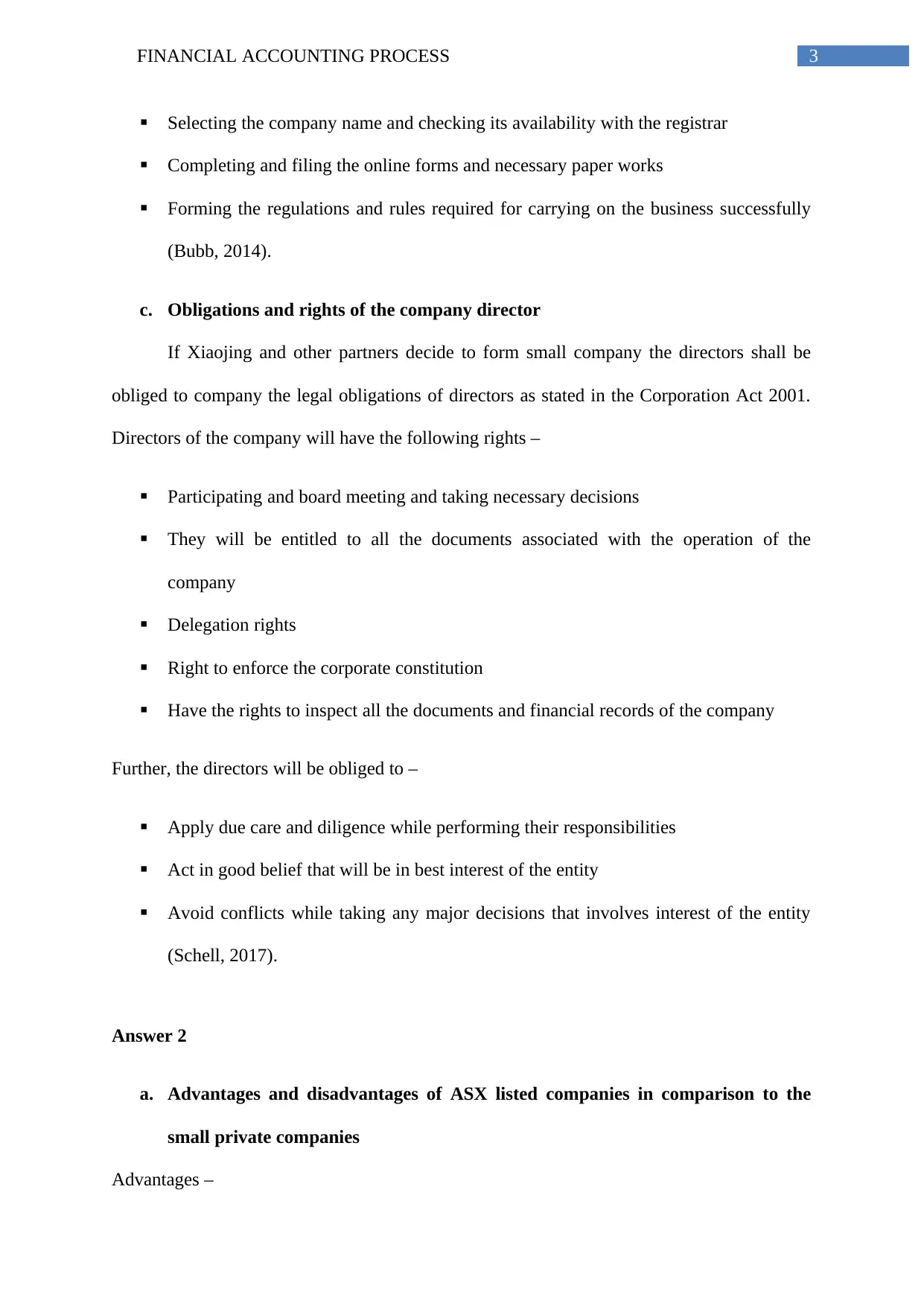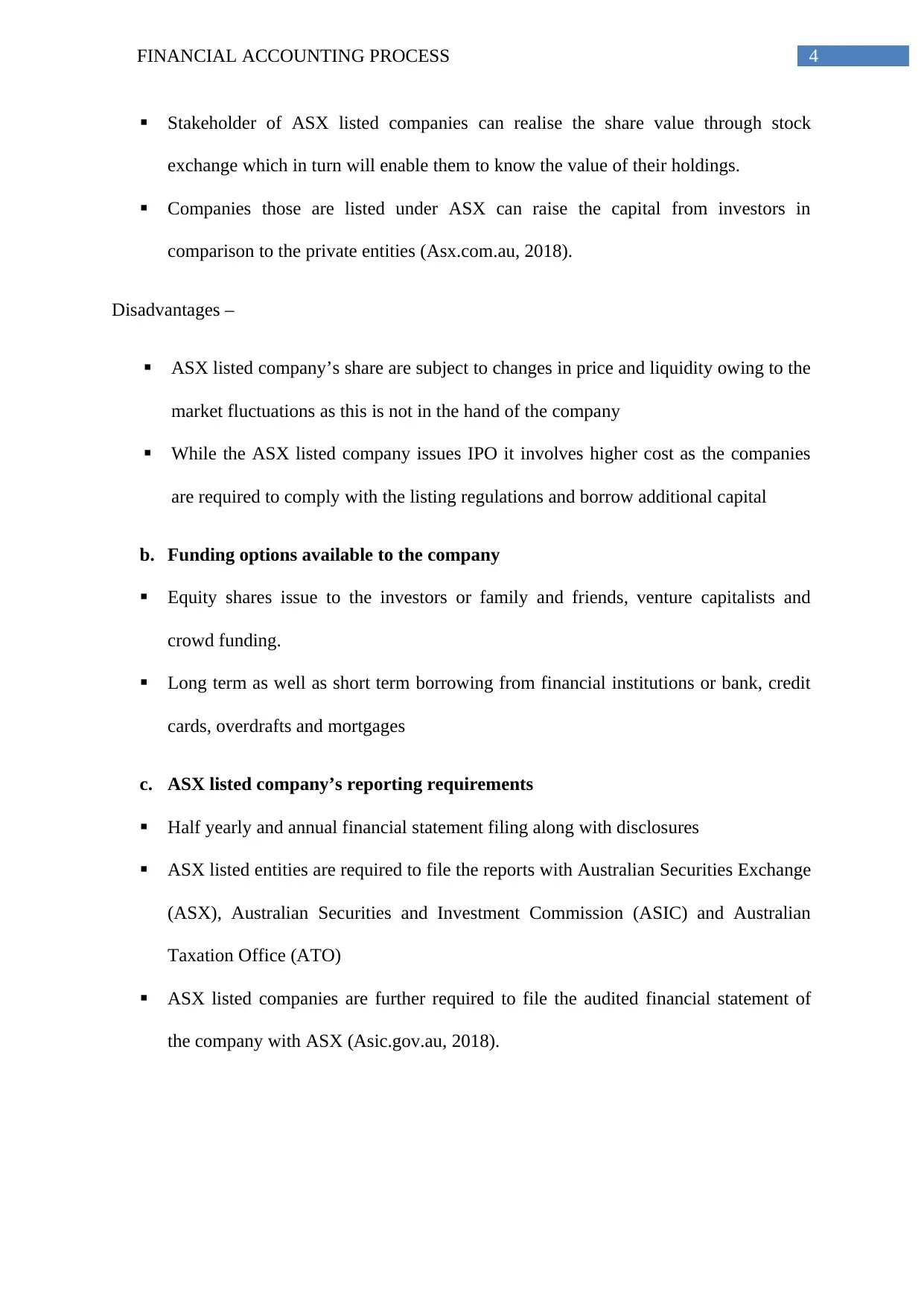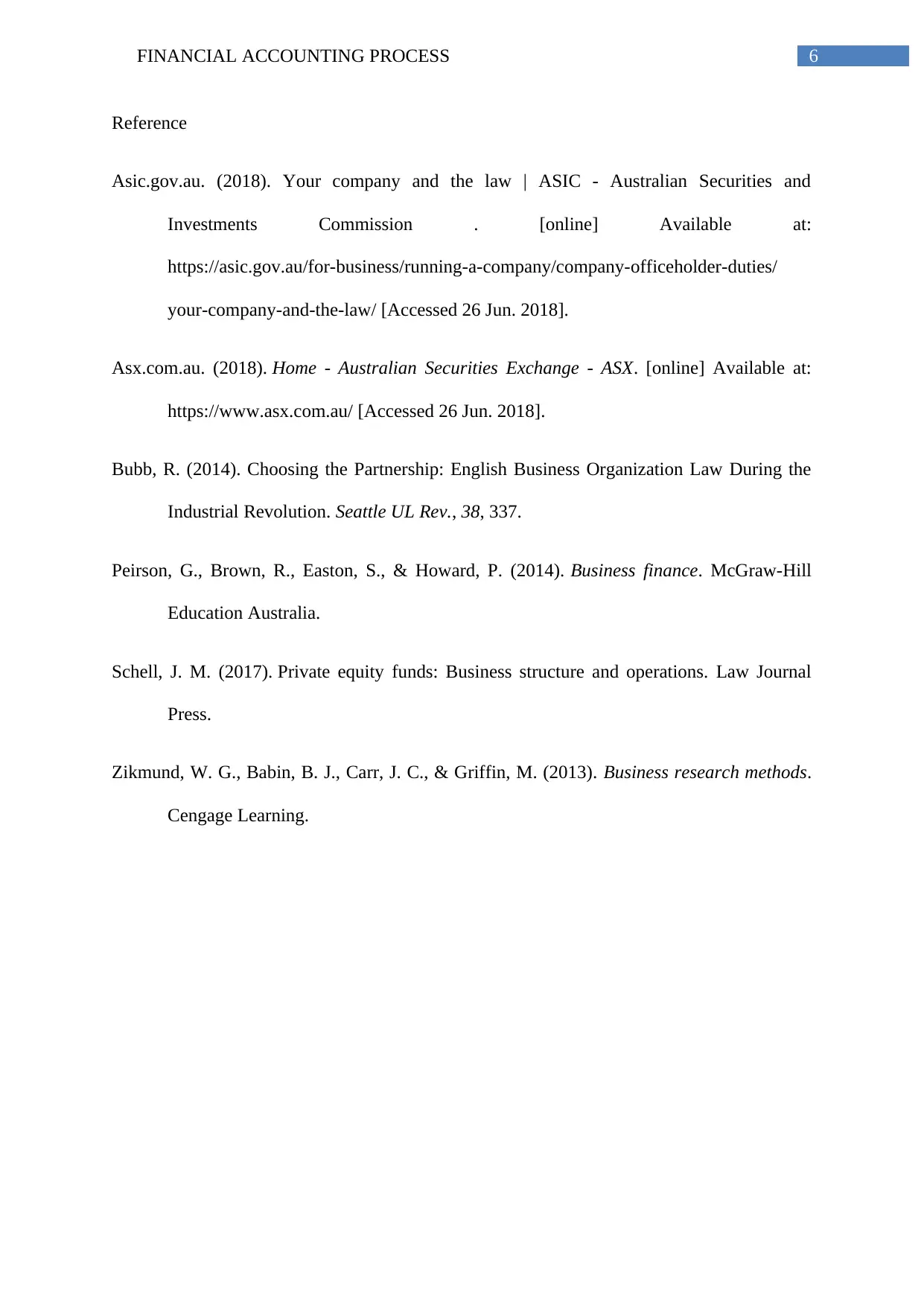ACCT6003 Financial Accounting: Regulations, Structures & Reporting
VerifiedAdded on 2023/06/10
|7
|1029
|88
Report
AI Summary
This assignment delves into the financial accounting processes relevant to business structures, focusing on a case study involving an entrepreneur named Xiaojing Wu. It compares the advantages and disadvantages of partnerships versus proprietary companies, outlines the steps required to set up a small proprietary concern in Australia, and details the obligations and rights of company directors. Furthermore, the assignment contrasts ASX-listed companies with small private companies, examines funding options available to companies, and specifies the reporting requirements for ASX-listed entities, including half-yearly and annual financial statement filings with various regulatory bodies like the ASX, ASIC, and ATO. The analysis concludes with a recommendation for Xiaojing to form a small business company to leverage business opportunities, referencing relevant accounting standards and regulations.

Running head: FINANCIAL ACCOUNTING PROCESS
Financial accounting process
Name of the student
Name of the university
Author note
Financial accounting process
Name of the student
Name of the university
Author note
Paraphrase This Document
Need a fresh take? Get an instant paraphrase of this document with our AI Paraphraser

1FINANCIAL ACCOUNTING PROCESS
Table of Contents
Answer 1....................................................................................................................................2
a. Partnership advantages and disadvantages as compared to proprietary company..........2
b. Small proprietary concern set up.....................................................................................2
c. Obligations and rights of the company director..............................................................3
Answer 2....................................................................................................................................3
a. Advantages and disadvantages of ASX listed companies in comparison to the small
private companies...................................................................................................................3
b. Funding options available to the company......................................................................4
c. ASX listed company’s reporting requirements...............................................................4
Table of Contents
Answer 1....................................................................................................................................2
a. Partnership advantages and disadvantages as compared to proprietary company..........2
b. Small proprietary concern set up.....................................................................................2
c. Obligations and rights of the company director..............................................................3
Answer 2....................................................................................................................................3
a. Advantages and disadvantages of ASX listed companies in comparison to the small
private companies...................................................................................................................3
b. Funding options available to the company......................................................................4
c. ASX listed company’s reporting requirements...............................................................4

2FINANCIAL ACCOUNTING PROCESS
Answer 1
a. Partnership advantages and disadvantages as compared to proprietary company
Advantages –
Proprietary company faces issues if they require fund for the business expansion as
the investors may not be interested in investing in the proprietary concern. Hence,
major portion of capital is to be arranged from the personal property of the owner. On
the other hand, the partners will be able to raise more funds from the investors
Legal requirements and filling obligation of proprietary company is more as
compared to the partnership business (Peirson et al., 2014).
Disadvantages –
In the proprietary concern the owner is entitled to entire profits of the business
whereas I partnership business the profits are divided by all the partners in the
business (Zikmund et al., 2013).
While taking any major business decision there may be conflict among the partners
whereas in case of proprietary concern the owner takes all the decisions.
b. Small proprietary concern set up
In the very 1st step to set up a small proprietary concern Xiaojing shall apply for
various legal documents like business name, registration of the company and the business
number to carry on business in Australia that is known as ABN number. After that Xiaojing
will require to carry on the following activities –
Decide whether the registered business will be set up in the territory of South
Australia or in any other place
Answer 1
a. Partnership advantages and disadvantages as compared to proprietary company
Advantages –
Proprietary company faces issues if they require fund for the business expansion as
the investors may not be interested in investing in the proprietary concern. Hence,
major portion of capital is to be arranged from the personal property of the owner. On
the other hand, the partners will be able to raise more funds from the investors
Legal requirements and filling obligation of proprietary company is more as
compared to the partnership business (Peirson et al., 2014).
Disadvantages –
In the proprietary concern the owner is entitled to entire profits of the business
whereas I partnership business the profits are divided by all the partners in the
business (Zikmund et al., 2013).
While taking any major business decision there may be conflict among the partners
whereas in case of proprietary concern the owner takes all the decisions.
b. Small proprietary concern set up
In the very 1st step to set up a small proprietary concern Xiaojing shall apply for
various legal documents like business name, registration of the company and the business
number to carry on business in Australia that is known as ABN number. After that Xiaojing
will require to carry on the following activities –
Decide whether the registered business will be set up in the territory of South
Australia or in any other place
⊘ This is a preview!⊘
Do you want full access?
Subscribe today to unlock all pages.

Trusted by 1+ million students worldwide

3FINANCIAL ACCOUNTING PROCESS
Selecting the company name and checking its availability with the registrar
Completing and filing the online forms and necessary paper works
Forming the regulations and rules required for carrying on the business successfully
(Bubb, 2014).
c. Obligations and rights of the company director
If Xiaojing and other partners decide to form small company the directors shall be
obliged to company the legal obligations of directors as stated in the Corporation Act 2001.
Directors of the company will have the following rights –
Participating and board meeting and taking necessary decisions
They will be entitled to all the documents associated with the operation of the
company
Delegation rights
Right to enforce the corporate constitution
Have the rights to inspect all the documents and financial records of the company
Further, the directors will be obliged to –
Apply due care and diligence while performing their responsibilities
Act in good belief that will be in best interest of the entity
Avoid conflicts while taking any major decisions that involves interest of the entity
(Schell, 2017).
Answer 2
a. Advantages and disadvantages of ASX listed companies in comparison to the
small private companies
Advantages –
Selecting the company name and checking its availability with the registrar
Completing and filing the online forms and necessary paper works
Forming the regulations and rules required for carrying on the business successfully
(Bubb, 2014).
c. Obligations and rights of the company director
If Xiaojing and other partners decide to form small company the directors shall be
obliged to company the legal obligations of directors as stated in the Corporation Act 2001.
Directors of the company will have the following rights –
Participating and board meeting and taking necessary decisions
They will be entitled to all the documents associated with the operation of the
company
Delegation rights
Right to enforce the corporate constitution
Have the rights to inspect all the documents and financial records of the company
Further, the directors will be obliged to –
Apply due care and diligence while performing their responsibilities
Act in good belief that will be in best interest of the entity
Avoid conflicts while taking any major decisions that involves interest of the entity
(Schell, 2017).
Answer 2
a. Advantages and disadvantages of ASX listed companies in comparison to the
small private companies
Advantages –
Paraphrase This Document
Need a fresh take? Get an instant paraphrase of this document with our AI Paraphraser

4FINANCIAL ACCOUNTING PROCESS
Stakeholder of ASX listed companies can realise the share value through stock
exchange which in turn will enable them to know the value of their holdings.
Companies those are listed under ASX can raise the capital from investors in
comparison to the private entities (Asx.com.au, 2018).
Disadvantages –
ASX listed company’s share are subject to changes in price and liquidity owing to the
market fluctuations as this is not in the hand of the company
While the ASX listed company issues IPO it involves higher cost as the companies
are required to comply with the listing regulations and borrow additional capital
b. Funding options available to the company
Equity shares issue to the investors or family and friends, venture capitalists and
crowd funding.
Long term as well as short term borrowing from financial institutions or bank, credit
cards, overdrafts and mortgages
c. ASX listed company’s reporting requirements
Half yearly and annual financial statement filing along with disclosures
ASX listed entities are required to file the reports with Australian Securities Exchange
(ASX), Australian Securities and Investment Commission (ASIC) and Australian
Taxation Office (ATO)
ASX listed companies are further required to file the audited financial statement of
the company with ASX (Asic.gov.au, 2018).
Stakeholder of ASX listed companies can realise the share value through stock
exchange which in turn will enable them to know the value of their holdings.
Companies those are listed under ASX can raise the capital from investors in
comparison to the private entities (Asx.com.au, 2018).
Disadvantages –
ASX listed company’s share are subject to changes in price and liquidity owing to the
market fluctuations as this is not in the hand of the company
While the ASX listed company issues IPO it involves higher cost as the companies
are required to comply with the listing regulations and borrow additional capital
b. Funding options available to the company
Equity shares issue to the investors or family and friends, venture capitalists and
crowd funding.
Long term as well as short term borrowing from financial institutions or bank, credit
cards, overdrafts and mortgages
c. ASX listed company’s reporting requirements
Half yearly and annual financial statement filing along with disclosures
ASX listed entities are required to file the reports with Australian Securities Exchange
(ASX), Australian Securities and Investment Commission (ASIC) and Australian
Taxation Office (ATO)
ASX listed companies are further required to file the audited financial statement of
the company with ASX (Asic.gov.au, 2018).

5FINANCIAL ACCOUNTING PROCESS
Looking into the above discussion it is recommended that Xiaojing shall form small
business company rather than continuing with the partnership business to avail various
business opportunities.
Looking into the above discussion it is recommended that Xiaojing shall form small
business company rather than continuing with the partnership business to avail various
business opportunities.
⊘ This is a preview!⊘
Do you want full access?
Subscribe today to unlock all pages.

Trusted by 1+ million students worldwide

6FINANCIAL ACCOUNTING PROCESS
Reference
Asic.gov.au. (2018). Your company and the law | ASIC - Australian Securities and
Investments Commission . [online] Available at:
https://asic.gov.au/for-business/running-a-company/company-officeholder-duties/
your-company-and-the-law/ [Accessed 26 Jun. 2018].
Asx.com.au. (2018). Home - Australian Securities Exchange - ASX. [online] Available at:
https://www.asx.com.au/ [Accessed 26 Jun. 2018].
Bubb, R. (2014). Choosing the Partnership: English Business Organization Law During the
Industrial Revolution. Seattle UL Rev., 38, 337.
Peirson, G., Brown, R., Easton, S., & Howard, P. (2014). Business finance. McGraw-Hill
Education Australia.
Schell, J. M. (2017). Private equity funds: Business structure and operations. Law Journal
Press.
Zikmund, W. G., Babin, B. J., Carr, J. C., & Griffin, M. (2013). Business research methods.
Cengage Learning.
Reference
Asic.gov.au. (2018). Your company and the law | ASIC - Australian Securities and
Investments Commission . [online] Available at:
https://asic.gov.au/for-business/running-a-company/company-officeholder-duties/
your-company-and-the-law/ [Accessed 26 Jun. 2018].
Asx.com.au. (2018). Home - Australian Securities Exchange - ASX. [online] Available at:
https://www.asx.com.au/ [Accessed 26 Jun. 2018].
Bubb, R. (2014). Choosing the Partnership: English Business Organization Law During the
Industrial Revolution. Seattle UL Rev., 38, 337.
Peirson, G., Brown, R., Easton, S., & Howard, P. (2014). Business finance. McGraw-Hill
Education Australia.
Schell, J. M. (2017). Private equity funds: Business structure and operations. Law Journal
Press.
Zikmund, W. G., Babin, B. J., Carr, J. C., & Griffin, M. (2013). Business research methods.
Cengage Learning.
1 out of 7
Related Documents
Your All-in-One AI-Powered Toolkit for Academic Success.
+13062052269
info@desklib.com
Available 24*7 on WhatsApp / Email
![[object Object]](/_next/static/media/star-bottom.7253800d.svg)
Unlock your academic potential
Copyright © 2020–2025 A2Z Services. All Rights Reserved. Developed and managed by ZUCOL.




